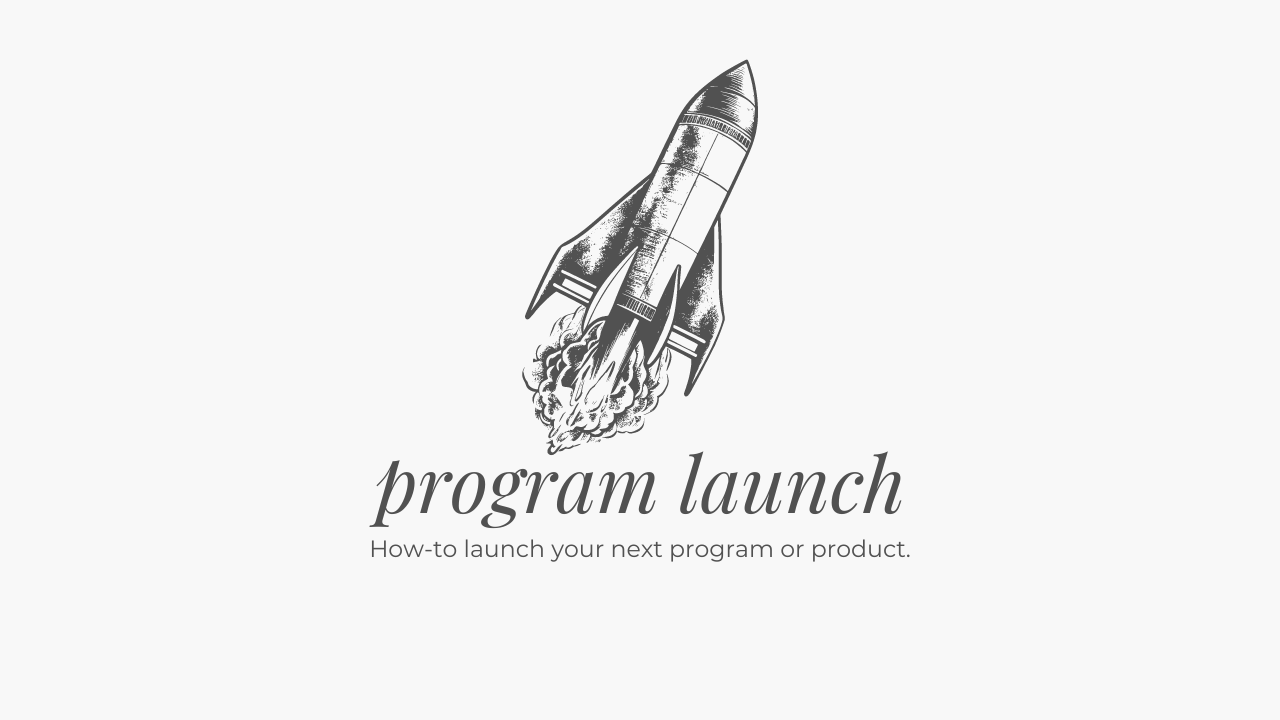Launching a new program or product is one of the most exciting phases in the lifecycle of any business. It’s the moment when all your hard work, ideas, and creativity are brought to life and introduced to the world. However, without proper planning, even the best ideas can fail to make an impact. “Hello, I am guilty of this myself.”
A well-executed launch can set the tone for your product’s success, while a poorly planned one can lead to missed opportunities. Here’s how I [try to] effectively plan for a successful program launch.
Define Clear Objectives
Before anything else, I establish what success looks like for my launch. Although, most of my launches have a revenue or enrollment goal, brand awareness or partnership leads, etc. could be your primary goal. By defining clear objectives, you’ll be able to focus your efforts and measure the success of your launch more effectively.
Questions to Ask:
- What are the specific goals of this launch?
- How will success be measured?
- What are the key performance indicators (KPIs) to track?
If this is your first time launching or you want to go deeper, following your objectives, you can also dive into your target audience and develop a Unique Selling Proposition (USP).
I usually skip those steps because I already have a solid handle on my customer and USP, or because I am drinking from the fire hose and I just need to get it launched. 😖
Next, I create a detailed Launch Plan in Notion.
“Roadmaps are evidence of strategy. Not a list of features.” —Steve Johnson
Create a Detailed Launch Plan
A successful launch requires a well-organized plan that covers all aspects of the launch process. This plan should include timelines, responsibilities, and contingencies to ensure everything runs smoothly.
Key Components:
- Timeline: Set specific deadlines for each phase of the launch. I like to work backward here, I set the launch date and then lock in milestones based on hitting the determined launch date.
- Task Assignments: Clearly define roles and responsibilities for your team members.
- Budget: Allocate resources for marketing, promotions, and other expenses.
- Contingency Plans: Prepare for potential challenges or setbacks that may arise.
Create a Marketing Strategy
Generating excitement before your launch is essential to capturing your audience’s attention and driving early interest. Pre-launch marketing activities can help build anticipation and create a sense of urgency around your product. (I also create this in Notion, within my planning template.)
Strategies to Consider:
- Teasers and Sneak Peeks: Share behind-the-scenes content or previews of your product.
- Email Marketing: Create a drip email campaign to keep your audience informed and engaged. I create these all at one time so that the flow makes sense from the start, then schedule them out accordingly. TIP: Send some of the post-launch, follow-up emails from a personal email.
- Influencer Partnerships: If this is your jam and part of your plan, collaborate with influencers in your industry to promote your upcoming launch.
- Social Media Campaigns: Use social media to generate buzz and interact with potential customers.
Prep Marketing Materials
All of your marketing materials should be ready to go before the launch. This includes everything from your website and landing pages to email campaigns and social media posts. Ensure that all materials are aligned with your brand and message.
Essential Materials:
- Landing Pages: Optimize for conversions with clear calls-to-action (CTAs) and compelling copy.
- Sales Assets: Create all materials for sales teams and partners.
- Email Templates: Design a series of emails for different stages of the launch, from announcements to follow-ups.
- Press: Fashion noteworthy announcements (with a great angle) that media and industry influencers would pick up and share.
Engage with Your Audience During the Launch
Interaction with your audience during the launch can drive engagement and encourage word-of-mouth promotion. Be responsive, ask and answer questions, and show appreciation for your customers’ support.
Engagement Tactics:
- Live AMA Sessions: Host a live webinar or social media Q&A to address questions and showcase your product.
- User-Generated Content: Encourage customers to share their experiences with your product on social media.
- Promotions and Discounts: Offer special launch discounts or incentives to drive early sales. Consider freebies, early bird sales, flash sales, and more!
Monitor and Measure the Results
Once your product is launched, it’s important to track the results to see if you’re meeting your objectives. Monitoring key metrics will help you identify areas for improvement and optimize your strategy for future launches.
Metrics to Track:
- Sales and Revenue: Measure the sales generated during the launch period.
- Customer Feedback: Collect feedback from early users to gauge satisfaction and identify any issues.
- Website Traffic: Monitor traffic to your website and landing pages.
- Conversion Rates: Analyze the effectiveness of your CTAs and marketing efforts.
Learn and Optimize
After the launch, take the time to analyze the results and learn from the experience. What worked well? What could be improved? Use these insights to refine your approach for future launches.
Post-Launch Activities:
- Team Debrief: Hold a meeting with your team to discuss the launch’s successes and challenges.
- Customer Follow-Up: Reach out to customers for feedback and reviews.
- Iterate and Improve: Use the insights gained to make improvements to your product or marketing strategy.
Conclusion
A successful program or product launch doesn’t happen by accident—it requires meticulous planning, a deep understanding of your audience, and a strategic approach to marketing. By following these steps, you’ll be well on your way to a launch that not only meets but exceeds your expectations. Remember, every launch is a learning experience, so stay flexible, keep refining your strategy, and celebrate your successes along the way!







